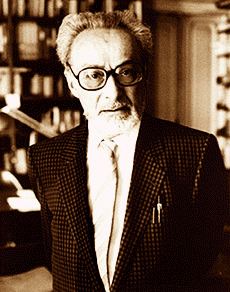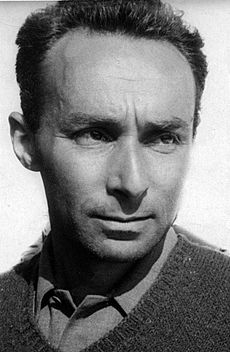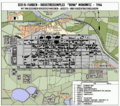Primo Levi facts for kids
Quick facts for kids
Primo Levi
|
|
|---|---|
 |
|
| Born | 31 July 1919 Turin, Italy |
| Died | 11 April 1987 (aged 67) Turin, Italy |
| Pen name | Damiano Malabaila (used for some of his fictional works) |
| Occupation | Writer, chemist |
| Language | Italian |
| Nationality | Italian |
| Education | Degree in chemistry |
| Alma mater | University of Turin |
| Period | 1947–1986 |
| Genre | Autobiography, short story, essay |
| Notable works |
|
| Spouse | Lucia Morpurgo (1920–2009) |
| Children | 2 |
Primo Michele Levi (31 July 1919 – 11 April 1987) was an Italian chemist, writer, and a Holocaust survivor. He was also a partisan, fighting against the Fascist and Nazi forces during World War II.
Primo Levi wrote many books, short stories, essays, and poems. His most famous book is If This Is a Man (also known as Survival in Auschwitz). This book shares his experiences as a prisoner in the Auschwitz concentration camp during the war. Another well-known work is The Periodic Table, which connects stories from his life to different chemical elements. This book was even called the "best science book ever written" by the Royal Institution.
Contents
Primo Levi's Life Story
Growing Up in Italy
Primo Levi was born in 1919 in Turin, Italy. He grew up in a Jewish family. His father, Cesare, worked for a company and traveled a lot. His mother, Ester, was well-educated and loved to read and play piano. Primo had a younger sister named Anna Maria, and they were very close.
As a child, Primo was shy but very smart in school. He often studied at home because he was sometimes sick. In the summers, he and his mother would go to the countryside, but his father preferred to stay in the city.
When he was 11, Primo joined the Massimo d'Azeglio Royal Gymnasium. He was the youngest and smallest in his class, and the only Jewish student. Some boys bullied him for being Jewish, which was hard for him. He also joined the Avanguardisti movement, which was for young Fascists, as was expected of all Italian boys. He avoided military drills by joining the ski team.
At 14, Primo went to the Liceo Classico D'Azeglio, a high school known for its teachers who were against Fascism. Reading a book about chemistry made him decide he wanted to become a chemist.
In 1938, Italy passed new Italian Racial Laws. These laws took away basic rights from Jewish people. Jewish students could not enter universities. Luckily, Primo had started university a year early, so he was allowed to continue his studies. He enrolled at the University of Turin to study chemistry.
In 1939, Primo found a new passion: mountain hiking. He loved the challenge and the feeling of freedom it gave him. This helped him forget the worries of Europe, which was heading towards war. In June 1940, Italy joined Germany in World War II. Turin was bombed, and Primo's father became very ill.
Chemistry Work and the War
Because of the racial laws, it was hard for Primo to find a job after graduating with a chemistry degree in 1941. His degree even had a note saying "of Jewish race."
He found a secret job working as a chemist at an asbestos mine. He had to use a false name. He later realized that if he succeeded, he would be helping the German war effort. In 1942, his father died. Primo then moved to Milan to work for a Swiss company, hoping to escape the racial laws.
In July 1943, Italy's leader, Mussolini, was removed from power. But soon, Germany took control of northern and central Italy. Primo and his family had to hide because they were Jewish. They moved to the mountains, a good place for resistance fighters.
Primo joined a partisan group in the Alps to fight against the Fascists. But in December 1943, he and his friends were arrested. When he was told he would be shot as a partisan, Primo confessed he was Jewish. He was sent to the Fossoli internment camp. At first, the camp was run by Italians, and he was not harmed.
Life in Auschwitz
Later, the Nazis took over Fossoli. They began sending Jewish prisoners to concentration camps in the east. On February 21, 1944, Primo Levi and other prisoners were forced into crowded cattle trucks. They were taken to Monowitz, which was part of the huge Auschwitz concentration camp complex.
Primo Levi spent eleven months in Auschwitz. He was prisoner number 174517. Of the 650 Italian Jews who arrived with him, only 20 survived. The average prisoner lived only three to four months.
Primo knew some German, which helped him understand the camp rules. He traded bread for German lessons. A kind Italian bricklayer named Lorenzo Perrone secretly gave Primo extra soup and bread, which saved his life.
In November 1944, Primo's chemistry skills helped him get a job in a laboratory. This meant he avoided hard labor outside in the freezing cold. He also stole materials from the lab to trade for more food. This helped him survive.
Just before the camp was freed, Primo got scarlet fever and was sent to the camp hospital. On January 18, 1945, the Nazi SS guards made most prisoners go on a long, deadly march away from the approaching Red Army. Because Primo was sick, he was left behind, which saved him from the "death march."
The Red Army freed Auschwitz on January 27, 1945. But Primo did not get home until October 19, 1945. He traveled a long, difficult route through many countries in Eastern Europe. He saw millions of people displaced by the war. This long journey is described in his book The Truce.
Becoming a Writer
When Primo returned to Turin, he was very thin and looked different. He was deeply affected by his experiences. He started telling his stories to people he met.
In 1946, he met Lucia Morpurgo, who later became his wife. Around this time, he began writing poems about Auschwitz. He also started working at a paint factory. He used his free time in the factory dormitory to write the first draft of If This Is a Man. He wrote down memories on scraps of paper every day.
By December 1946, the book was finished. Lucia helped him edit it. Many publishers rejected it at first because the war memories were still too painful for people. Finally, a small publisher named Franco Antonicelli agreed to publish it in October 1947.
Primo married Lucia in September 1947. Their daughter, Lisa, was born in 1948. Primo decided that being an independent chemist was too risky, so he started working for a paint company called SIVA.
Primo's friend Lorenzo Perrone, who had saved his life in Auschwitz, struggled after the war. Lorenzo died in 1952. Primo named both his children, Lisa Lorenza and Renzo, after him to honor his kindness.
As a chemist at SIVA, Primo traveled a lot, including to Germany. He made sure German businessmen and scientists saw his prison camp number tattooed on his arm. He also became involved in groups that remembered the Holocaust.
In 1958, a major publisher, Einaudi, re-published If This Is a Man. It was translated into English in 1959. Primo especially wanted the book translated into German so that German people could understand what had happened.
Later Writing and Legacy
Primo Levi published The Truce in 1963, which won a literary award. This book tells the story of his long journey home from Auschwitz. He also wrote science fiction short stories under the name Damiano Malabaila. These stories explored how new inventions might affect society.
In 1974, Primo semi-retired from his chemistry job to focus more on writing. In 1975, he published The Periodic Table, a collection of stories linked to chemical elements and his life. This book became very famous.
He fully retired in 1977 to write full-time. He wrote The Wrench (1978), a novel about an engineer who travels the world building things. It shows the importance of taking pride in one's work.
In 1984, he published his only other novel, If Not Now, When?. It is about a group of Jewish partisans fighting during World War II and trying to reach Palestine. This book was inspired by the strong, determined Jewish refugees he met on his journey home from Auschwitz.
Primo Levi became a very important writer in Italy, and his books were translated into many languages. The Truce became a book studied in Italian schools.
In 1986, he published The Drowned and the Saved. In this book, he tried to understand why people acted the way they did in Auschwitz and why some survived while others died. He explored difficult questions without making judgments.
Primo Levi died on April 11, 1987, after falling from his apartment building in Turin.
Primo Levi's Books
| Title | Year | Type | English language translations |
|---|---|---|---|
| Se questo è un uomo | 1947 and 1958 | Memoir | If This Is a Man (US: Survival in Auschwitz) |
| La tregua | 1963 | Memoir | The Truce (US: The Reawakening) |
| Storie naturali (as Damiano Malabaila) | 1966 | Short stories | The Sixth Day and Other Tales |
| Vizio di forma | 1971 | Short stories | Mainly in The Sixth Day and Other Tales. Some stories are in A Tranquil Star |
| Il sistema periodico | 1975 | Short stories | The Periodic Table |
| L'osteria di Brema | 1975 | Poems | In Collected Poems |
| Lilìt e altri racconti | 1981 | Short stories | Part 1: Moments of Reprieve. Some stories from Parts 2 and 3 are in A Tranquil Star |
| La chiave a stella | 1978 | Novel | The Wrench (US: The Monkey's Wrench) |
| La ricerca delle radici | 1981 | Personal anthology | The Search for Roots: A Personal Anthology |
| Se non ora, quando? | 1982 | Novel | If Not Now, When? |
| Ad ora incerta | 1984 | Poems | In Collected Poems |
| L'altrui mestiere | 1985 | Essays | Other People's Trades |
| I sommersi e i salvati | 1986 | Essays | The Drowned and the Saved |
| Racconti e Saggi | 1986 | Essays | The Mirror Maker |
| Conversazioni e interviste 1963–1987 | 1997 | Various (posthumous) | Conversations with Primo Levi and The Voice of Memory: Interviews, 1961–1987 |
| 2005 | Essays (posthumous) | The Black Hole of Auschwitz | |
| 2006 | Factual (posthumous) | Auschwitz Report | |
| 2007 | Short stories (posthumous) | A Tranquil Star | |
| 2011 | Short stories | The Magic Paint (Selection from A Tranquil Star) |
Books and Films Based on Primo Levi's Work
- Some of Primo Levi's poems have been turned into music.
- The 1997 film La Tregua (The Truce) was based on his 1963 memoir. It tells the story of his long journey home after being freed from Auschwitz.
- His book If This Is a Man was made into a one-person play called Primo in 2004.
Images for kids
See also
 In Spanish: Primo Levi para niños
In Spanish: Primo Levi para niños




